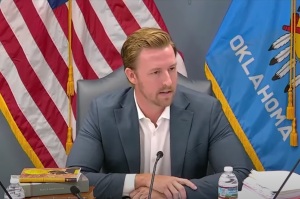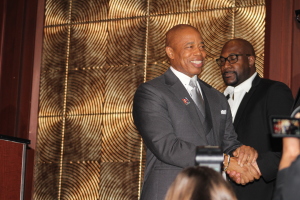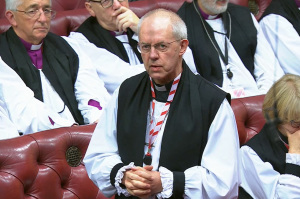The 'Baby Gap'--Parenthood and Politics
Pundits, political scientists, and observers of various stripes have been working hard to explain just what happened on November 2. The results of the election are clear enough by now, but the meaning of the election is still hotly debated. Various demographic trends, moral issues, and social trends have been offered as explanations for America's voting patterns. Missing from most of these discussions is something very obvious, very important, and very controversial--the "baby gap." Writing in The American Conservative, Steve Sailer identifies the baby gap as the factor almost no one mentions, even though the baby gap is "correlated uncannily with states' partisan splits in both 2000 and 2004."
In other words, America is divided between "red" [Republican] and "blue" [Democratic] states. That partisan divide, however, points to a more personal divide--between those states with high fertility rates and those with rates falling even below the replacement level.
According to Sailer, "voters are picking their parties based on differing approaches to the most fundamentally important human activity: having babies. The white people in Republican-voting regions consistently have more babies than the white people in Democratic-voting regions. The more kids whites have, the more pro-Bush they get." Sailer focused upon Caucasian voters, because these represent both the focus and the energy in the arguments over the red-blue division. Though other factors may well account for voting patterns among non-white ethnic groups, the red-blue divide hinges on the voting patterns of the dominant population.
The baby gap is a major factor on the electoral map, even though most observers have missed the issue entirely. Sailer focuses on the "total fertility rate," an estimate of the total number of children the average woman is likely to bear during her childbearing years. As Sailer reports, the National Center for Health Statistics reported that for 2002 the average white woman was giving birth at a fertility rate of 1.83. That's thirteen percent below the replacement rate of 2.1 births per woman.
Nevertheless, the states represent very different reproduction patterns. The highest level of fertility among whites is found in Utah, the only state where Bush received over 70 percent of the vote. Women there average 2.45 babies compared to only 1.11 babies in Washington, D.C., where Bush received only nine percent of the vote.
Sailer summarized the correlation between fertility rates and voting patterns in the 2004 election. "The three New England states where Bush won less than 40 percent--Massachusetts, Vermont, and Rhode Island--are three of the four states with the lowest white birthrates, with little Rhode Island dipping below 1.5 babies per woman." On the other hand, "Bush carried the 19 states with the highest white fertility (just as he did in 2000), and 25 out of the top 26, with highly unionized Michigan being the one blue exception to the rule." Sailer went on to identify West Virginia, North Dakota, and Florida as the red states reporting lower fertility rates.
Kerry won all sixteen states at the bottom of the fertility list, and the states Sailer correctly identifies as the "Democrats' anchor states" (California and New York) reported fertility rates of only 1.65 and 1.72, respectively.
Does this really amount to a significant electoral impact? Sailer responds with a quick argument that underlines the importance of the fertility factor: "You could predict 74 percent of the variation in Bush's shares just from knowing each state's white fertility rate. When the average fertility goes up by a tenth of a child, Bush's share normally goes up by 4.5 points." That represents a hugely significant demographic factor with an immediate political impact.
Just as Sailer's cover article in The American Conservative appeared, David Brooks addressed the same issue in his op-ed column published in The New York Times. Writing in the December 7, 2004 edition of the paper, Brooks addressed "the new red-diaper babies." Though the old "red-diaper babies" were the offspring of American communists, the new babies Brooks has noticed are those born to parents in Republican-leaning states.
Taking a cue from the social sciences, Brooks identifies high-fertility parents as a new social movement sweeping the nation, a movement known as "natalism." Put simply, natalists are those committed to bearing and raising children. "All across the industrialized world, birth rates are falling--in Western Europe, in Canada and in many regions of the United States," Brooks observes. "People are marrying later and having fewer kids. But spread around this country, and concentrated in certain areas, the natalists defy these trends."
Who are these people? "They are having three, four or more kids. Their personal identity is defined by parenthood. They are more spiritually, emotionally and physically invested in their homes than in any other sphere of life, having concluded that parenthood is the most enriching and elevating thing they can do. Very often they have sacrificed pleasures like sophisticated movies, restaurant dining and foreign travel, let alone competitive careers and disposable income, for the sake of their parental calling."
Just after the election, the Los Angeles Times published a report indicating that President George W. Bush swept most of the fastest-growing counties in America. As a matter of fact, Bush's margin of victory in those counties amounted to nothing less than a landslide. Brooks notes that these fast-growing regions "tend to have the highest concentrations of children." The exploding suburbs feature exploding fertility rates, busy maternity wards, and family-friendly environments.
"If you wanted a one-sentence explanation for the explosive growth of far-flung suburbs," Brooks argues, "it would be that when people get money, one of the first things they do is use it to try to protect their children from bad influences."
Brooks' argument is easy to follow. As he sees it, Republicans have a firm grip on those states and regions marked by high fertility and populated by voters very concerned with the tasks and responsibilities of raising children.
Steve Sailer noticed many of these same demographic patterns. "When city couples marry, they face major decisions: do they enjoy the adult-oriented cultural amenities of the city so much that they will stick it out, or do they head for the suburbs, exurbs, or even the country to afford more space for a growing family?"
Looking around the country, Sailer observes what he calls the "sexual organization of society." With great plausibility, he argues that demographic patterns have as much to do with sexual activity as with economic and other factors.
Conservatives are not alone in coming to this realization. Brooks points to Joel Kotkin and William Frey who observed in The New Republic Online, "Democrats swept the largely childless cities--true blue locales like San Francisco, Portland, Seattle, Boston and Manhattan have the lowest percentage of children in the nation--but generally had poor showings in most places where families are settling down, notably the Sun Belt cities, exurbs and outer suburbs of older metropolitan areas."
Demography may not be destiny, but in matters as mathematic as election results, demographic factors can come close to determining the outcome. Brooks understands that the fertility rate is tied to larger issues of worldview. "Natalists resist the declining fertility trends not because of income, education or other socioeconomic characteristics. It's attitudes. People with larger families tend to attend religious services more often, and tend to have more traditional gender roles."
Democrats--and American liberals in general--have a new concern on their hands. Conservatives are literally outpopulating liberals, and it's not all due to pregnancies. Abortion also plays a role. This factor was conclusively examined by James Taranto of The Wall Street Journal in his series of articles on "the Roe effect." As Taranto demonstrates, liberals tend to have far more abortions than conservatives, and liberal Democratic women--or those women most likely to vote for a Democratic candidate--are most likely to have abortions.
The Alan Guttmacher Institute, supported by Planned Parenthood, provides statistics on abortions nationwide, and the statistics for the last presidential election year (2000) prove that Taranto is on to something. In 2000, Al Gore carried the District of Columbia with 76.2 percent of the vote. That same year, the abortion rate among teenage girls in D.C. ran 55 per 1000 girls and young women, age fifteen through nineteen. That is an incredible statistic, indicating that at least one out of every twenty teenage girls living in the District of Columbia had an abortion in the year 2000. Most significantly, the highest rates of voting for the Democratic presidential candidate and the highest rate of teenage abortion came from the same geographic and political unit.
A similar pattern is evident throughout the fifty states. With few exceptions, abortion rates correlate closely with election outcomes.
All this is very politically incorrect, of course. James Pinkerton, never afraid to be politically incorrect, argued in his Newsday column that "the left has birth-controlled, aborted, and maybe also gay-libbed itself into a smaller role in American society."
Parenthood, fertility rates, and voting patterns correlate so closely precisely because voting patterns reveal values and worldview commitments. The "baby gap" phenomenon draws attention to two related realities. In the first place, conservatives tend to have more children than liberals. Secondly, parenthood tends to influence voters in a more conservative direction. The responsibilities, experiences, and disciplines of parenthood--along with a parent's obvious concern for the future--tend to move child-rearing voters to the right.
Of course, Christian parents know that there is more to this picture than politics. Children are gifts from God, and these precious gifts are to be raised in the nurture and admonition of the Lord. Parents serious about this great task are likely to be serious about politics as well, and that's why the "baby gap" is likely to be an important political factor for a long time to come.
_______________________________________________
R. Albert Mohler, Jr. is president of The Southern Baptist Theological Seminary in Louisville, Kentucky. For more articles and resources by Dr. Mohler, and for information on The Albert Mohler Program, a daily national radio program broadcast on the Salem Radio Network, go to www.albertmohler.com. For information on The Southern Baptist Theological Seminary, go to www.sbts.edu. Send feedback to mail@albertmohler.com. Original copy from crosswalk.com





























